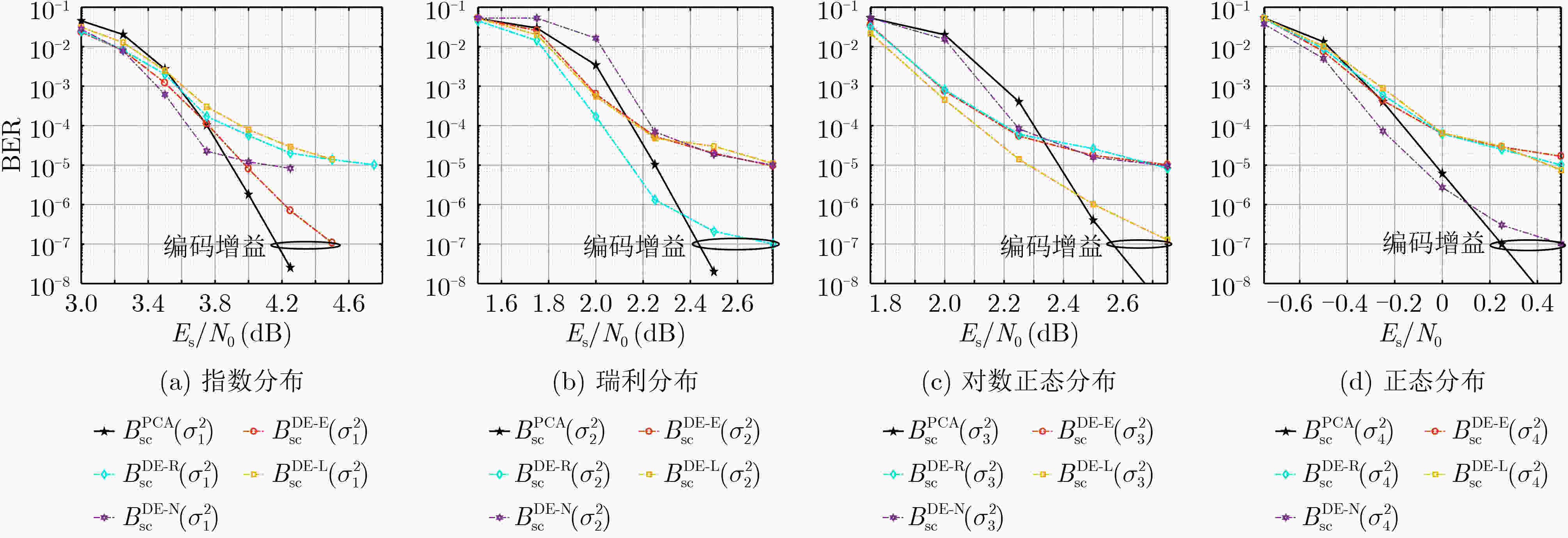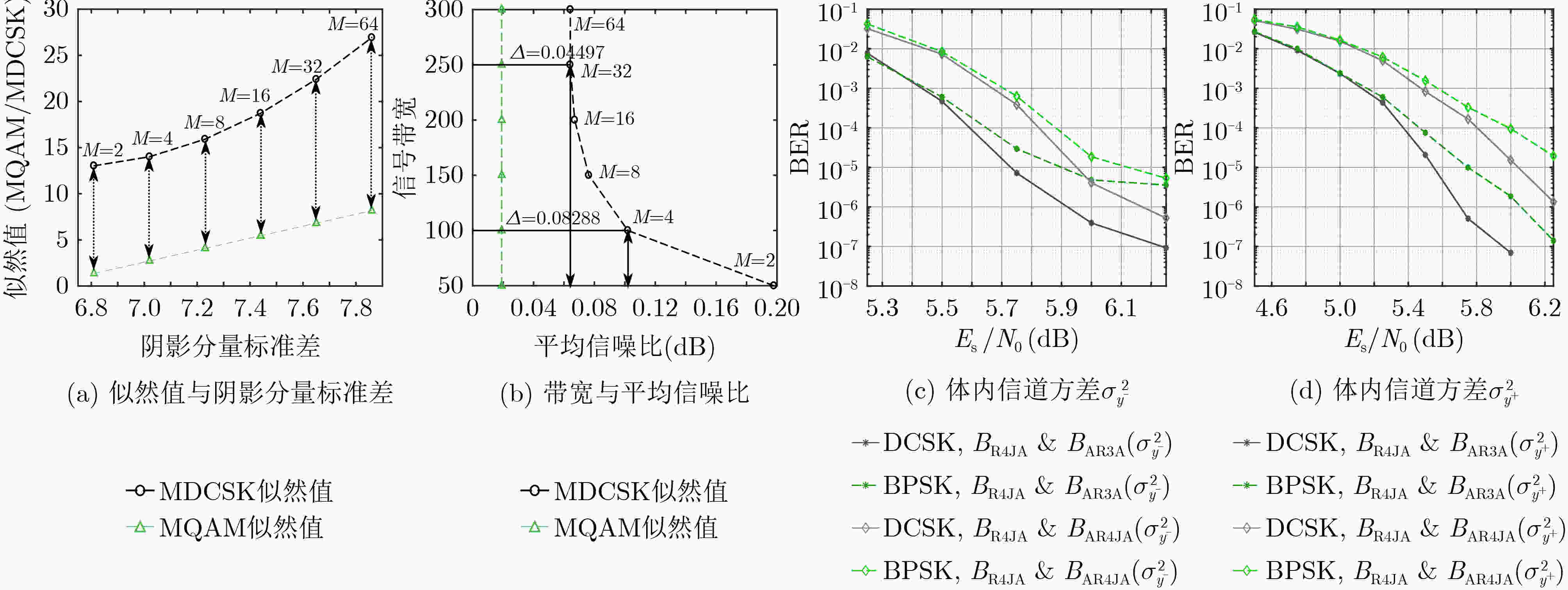Survey of Transmission Coding Theory on Physical Layer for Wireless Body Area Network: Optimal Design of Low-Density Parity-Check Code
-
摘要: 面向无线体域网(WBAN)传输环境,该文主要论述信道编码与联合信源信道编码系统的码字设计。针对物理层的低功耗和高可靠传输需求,从低密度奇偶校验(LDPC)码的优化设计角度展开,主要在信道模型分类、传输系统构建、技术挑战与解决方案、信道适配性编码设计这4个层面进行梳理和总结。最后,对WBAN环境下LDPC码优化设计的未来研究工作进行展望,为构建下一代通信技术提供参考。Abstract: In this paper, the code designs based on the channel coding and the joint source channel coding systems are surveyed over the transmission environment of the Wireless Body Area Network (WBAN). For the requirements of low-power consumption and high reliability on the physical layer, the perspective of optimal design based on the Low-Density Parity-Check (LDPC) code is investigated. Four aspects are summarized, including the classification of channel models, the construction of transmission system, the technical challenges and solutions, and the coding design with channel adaptability. Finally, some future works are prospected for optimally designing the LDPC codes over the WBAN environment, which will provide some references to construct the next-generation communication technology.
-
图 3 使用NGA方法修正EXIT算法[9]
图 4 韦布尔运动信道在4种分布下,优化公用码型与现有DE码型的BER性能比较[10]
图 5 体内信道的MDCSK, MQAM和BPSK调制方案比较[9]
表 1 信道模型及传输场景分类[7]
信道模型 场景标记 具体传输场景描述 CM1 S1 植入节点→植入节点 CM2 S2 植入节点→体表节点 CM2 S3 植入节点→体外节点 CM3 S4 体表节点→体表节点(视距传输) CM3 S5 体表节点→体表节点(非视距传输) CM4 S6 体表节点→体外节点(视距传输) CM4 S7 体表节点→体外节点(非视距传输) 表 2 人体静止状态下体表节点发送信息通过体表信道模型拟合的概率密度函数[7]
体表节点的位置 概率密度函数分布 体表节点的位置 概率密度函数分布 右侧腕部 正态分布 右侧上臂 对数正态分布 头部 韦布尔分布 右耳 正态分布 肩部 对数正态分布 胸部 对数正态分布 右侧肋骨 对数正态分布 左侧腰部 正态分布 右侧大腿 对数正态分布 右脚踝 对数正态分布 表 3 人体运动状态下体表节点发送信息通过体表信道模型拟合的概率密度函数[7]
体表节点位置 慢速行走 上下蹲起 体表节点位置 慢速行走 上下蹲起 右侧腕部 韦布尔分布 韦布尔分布 胸部 对数正态分布 韦布尔分布 右侧上臂 韦布尔分布 韦布尔分布 右侧肋骨 对数正态分布 韦布尔分布 头部 对数正态分布 对数正态分布 左侧腰部 对数正态分布 韦布尔分布 右耳 对数正态分布 韦布尔分布 右侧大腿 对数正态分布 韦布尔分布 肩部 韦布尔分布 韦布尔分布 右脚踝 韦布尔分布 韦布尔分布 -
[1] QADRI Y A, NAUMAN A, BIN ZIKRIA Y, et al. The future of Healthcare Internet of Things: A survey of emerging technologies[J]. IEEE Communications Surveys & Tutorials, 2020, 22(2): 1121–1167. doi: 10.1109/COMST.2020.2973314 [2] 2022中国AIoT产业全景图谱报告[R]. 物联网智库, 2022.2022 China AIoT industry panorama report[R]. IoT Think Tank, 2022. [3] 健康物联网白皮书[R]. 北京: 中国电子技术标准化研究院, 2020.Health IoT white paper[R]. Beijing: China Electronics Standardization Institute, 2020. [4] SAKKATTU H and PRASAD D. Performance evaluation of IEEE 802.15. 6 in wireless body area networks[C]. 2018 International Conference on Electrical, Electronics, Communication, Computer, and Optimization Techniques (ICEECCOT), Msyuru, India, 2018: 670–674. [5] MUCCHI L, JAYOUSI S, CAPUTO S, et al. Performance of wireless body area networks for health: ETSI SmartBAN or Bluetooth?[C]. 2021 XXXIVth General Assembly and Scientific Symposium of the International Union of Radio Science (URSI GASS), Rome, Italy, 2021: 1–4. [6] NGUYEN H T and NGUYEN T V. Energy-efficient and low complexity channel coding for wireless body area networks[C]. 2018 5th NAFOSTED Conference on Information and Computer Science (NICS), Ho Chi Minh City, Vietnam, 2018: 265–269. [7] FOERSTER J R. Channel modeling subcommittee report[R]. IEEE 802. 15 workgroup official website, 2003. [8] SONG Dan, WANG Lin, CHEN Qiwang, et al. Optimal design of joint protomatrix for DP-LDPC codes-based JSCC system over on-body channel[J]. IEEE Access, 2021, 9: 33091–33101. doi: 10.1109/ACCESS.2021.3061134 [9] SONG Dan, WANG Lin, XU Zhiping, et al. Joint code rate compatible design of DP-LDPC code pairs for joint source channel coding over implant-to-external channel[J]. IEEE Transactions on Wireless Communications, 2022, 21(7): 5526–5540. doi: 10.1109/TWC.2022.3141729 [10] SONG Dan, REN Jinkai, WANG Lin, et al. Designing a common DP-LDPC code pair for variable on-body channels[J]. IEEE Transactions on Wireless Communications, 2022, 21(11): 9596–9609. doi: 10.1109/TWC.2022.3178207 [11] CAI Guofa, FANG Yi, CHEN Pingping, et al. Design of an MISO-SWIPT-aided code-index modulated multi-carrier M-DCSK system for e-Health IoT[J]. IEEE Journal on Selected Areas in Communications, 2021, 39(2): 311–324. doi: 10.1109/JSAC.2020.3020603 [12] XU Yihan, YU Gang, and YONG Y T. Deep reinforcement learning-based resource scheduling strategy for reliability-oriented wireless body area networks[J]. IEEE Sensors Letters, 2021, 5(1): 1–4. doi: 10.1109/LSENS.2020.3044337 [13] 3rd Generation Partnership Project. 3GPP TS 38. 201[S]. 3GPP Organizational Partners’ Publications Offices, 2017. [14] GALLAGER R. Low-density parity-check codes[J]. IRE Transactions on Information Theory, 1962, 8(1): 21–28. doi: 10.1109/TIT.1962.1057683 [15] 吕毅博, 胡伟, 王琳. Beyond-BP译码算法综述: 原理与应用[J]. 电子与信息学报, 2017, 39(6): 1503–1514. doi: 10.11999/JEIT161288LÜ Yibo, HU Wei, and WANG Lin. Survey of beyond-BP decoding algorithms: Theory and applications[J]. Journal of Electronics &Information Technology, 2017, 39(6): 1503–1514. doi: 10.11999/JEIT161288 [16] SAITO A and AOYAGI T. Development of a synchronous measurement system for WBAN channel modeling considering human body motion[C]. 2022 IEEE 16th International Symposium on Medical Information and Communication Technology (ISMICT), Lincoln, USA, 2022: 1–6. [17] 石晶晶, 刘力嘉, 韩福晔, 等. 人体通信频段体内至体表信道特性分析与建模[J]. 电子与信息学报, 2022, 44(5): 1819–1827. doi: 10.11999/JEIT210267SHI Jingjing, LIU Lijia, HAN Fuye, et al. In-body to on-body channel characteristics analysis and modeling in human body communication frequency band[J]. Journal of Electronics &Information Technology, 2022, 44(5): 1819–1827. doi: 10.11999/JEIT210267 [18] GENG Yishuang, WAN Yadong, HE Jie, et al. An empirical channel model for the effect of human body on ray tracing[C]. 2013 IEEE 24th Annual International Symposium on Personal, Indoor, and Mobile Radio Communications (PIMRC), London, UK, 2013: 47–52. [19] WANG Qianqian, GUAN Quansheng, CHENG Julian, et al. A splitting-detection joint-decision receiver for ultrasonic intra-body communications[J]. IEEE Transactions on Communications, 2021, 69(6): 3586–3597. doi: 10.1109/TCOMM.2021.3064967 [20] CHAMAANI S, NECHAYEV Y I, HALL P S, et al. In-body to off-body channel modeling[C]. The 2010 Loughborough Antennas & Propagation Conference (LAPC), Loughborough, UK, 2010: 609–612. [21] SEWAILEM M F and BAKLIZI A. Inference for the log-logistic distribution based on an adaptive progressive type-II censoring scheme[J]. Cogent Mathematics & Statistics, 2019, 6(1): 1684228. doi: 10.1080/25742558.2019.1684228 [22] 金添, 何元, 李新羽, 等. 超宽带雷达人体行为感知研究进展[J]. 电子与信息学报, 2022, 44(4): 1147–1155. doi: 10.11999/JEIT211044JIN Tian, HE Yuan, LI Xinyu, et al. Advances in human activity sensing using ultra-wide band radar[J]. Journal of Electronics &Information Technology, 2022, 44(4): 1147–1155. doi: 10.11999/JEIT211044 [23] NCSS Statistical Software: Distribution Weibull fitting[EB/OL]. https://www.ncss.com/wpcontent/themes/ncss/pdf/Procedures/NCSS/Distribution-Weibull-Fitting.pdf. [24] TEN BRINK S, KRAMER G, and ASHIKHMIN A. Design of low-density parity-check codes for modulation and detection[J]. IEEE Transactions on Communications, 2004, 52(4): 670–678. doi: 10.1109/TCOMM.2004.826370 [25] TEN BRINK S. Convergence behavior of iteratively decoded parallel concatenated codes[J]. IEEE Transactions on Communications, 2001, 49(10): 1727–1737. doi: 10.1109/26.957394 [26] FLIZIKOWSKI A, HOLUBOWICZ W, PRZYBYSZEWSKI M, et al. Admission control and system capacity assessment of WiMAX with ACM and nb-LDPC codes simulation study with ViMACCS ns2 patch[C]. 2010 24th IEEE International Conference on Advanced Information Networking and Applications, Perth, Australia, 2010: 1077–1084. [27] GROSA P, DOS SANTOS A F, LENTMAIER M, et al. Application of protograph-based LDPC codes for UWB short range communication[C]. 2010 IEEE International Conference on Ultra-Wideband, Nanjing, China, 2010: 1–4. [28] DIVSALAR D, DOLINAR S, JONES C R, et al. Capacity-approaching protograph codes[J]. IEEE Journal on Selected Areas in Communications, 2009, 27(6): 876–888. doi: 10.1109/JSAC.2009.090806 [29] SANSODA B, CHOOMCHUAY S, TIMAKUL S, et al. Performance evaluation of LDPC codes on patterned WBAN data[C]. TENCON 2014 - 2014 IEEE Region 10 Conference, Bangkok, Thailand, 2014: 1–4. [30] CHEN Pingping, SHI Long, FANG Yi, et al. A coded DCSK modulation system over Rayleigh fading channels[J]. IEEE Transactions on Communications, 2018, 66(9): 3930–3942. doi: 10.1109/TCOMM.2018.2827032 [31] CHEN Qiwang and WANG Lin. Design and analysis of joint source channel coding schemes over non-standard coding channels[J]. IEEE Transactions on Vehicular Technology, 2020, 69(5): 5369–5380. doi: 10.1109/TVT.2020.2984235 [32] Industrial IOT Artificial Intelligence Framework[R]. Industry IoT Consortium, 2022. -






 下载:
下载:






 下载:
下载:
